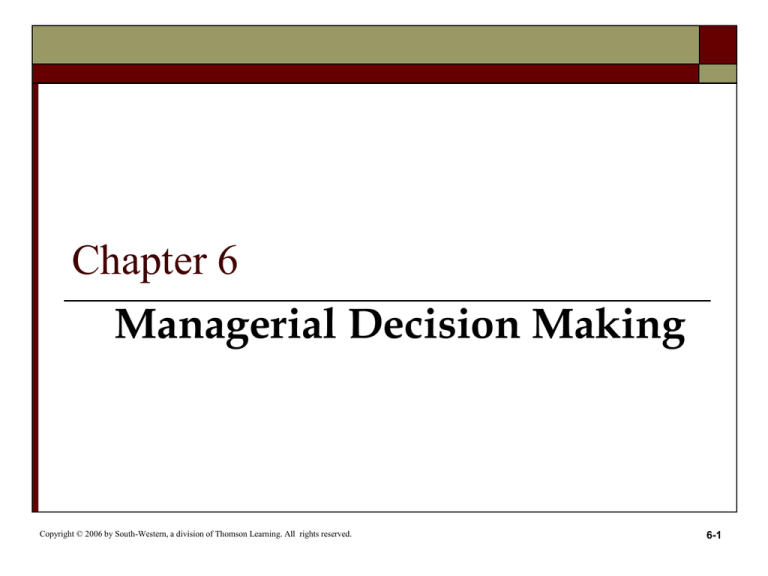
Chapter 6
Managerial Decision Making
Copyright © 2006 by South-Western, a division of Thomson Learning. All rights reserved.
6-1
Types of Decisions
Programmed decisions
situations that occur often enough to enable
decision rules to be developed.
Nonprogrammed decisions
are made in response to situations that are
unique, are poorly defined and largely
unstructured.
© 2006 by South-Western, a division of Thomson Learning. All rights reserved.
6-2
Decision Making Conditions
Certainty
all the information the decision maker needs is
fully available.
Risk
decision has clear-cut goals.
good information is available.
future outcomes associated with each
alternative are subject to chance.
© 2006 by South-Western, a division of Thomson Learning. All rights reserved.
6-3
Decision Making Conditions (contd.)
Uncertainty
managers know which goals they wish to
achieve.
information about alternatives and future
events is incomplete.
managers may have to come up with creative
approaches to alternatives.
© 2006 by South-Western, a division of Thomson Learning. All rights reserved.
6-4
Decision Making Conditions (contd.)
Ambiguity
by far the most difficult decision situation.
goals to be achieved or the problem to be
solved is unclear.
alternatives are difficult to define.
information about outcomes is unavailable.
© 2006 by South-Western, a division of Thomson Learning. All rights reserved.
6-5
Conditions That Affect the Possibility of
Decision Failure
Ex. 6.1
Organizational
Problem
Low
Possibility of Failure
Certainty
Risk
Uncertainty
Programmed
Decisions
High
Ambiguity
Nonprogrammed
Decisions
Problem
Solution
© 2006 by South-Western, a division of Thomson Learning. All rights reserved.
6-6
Three Decision Making Models
Political Model
Administrative Model
Classical Model
© 2006 by South-Western, a division of Thomson Learning. All rights reserved.
6-7
Selecting a Decision Making Model
Depends on the manager’s personal
preference.
Whether the decision is programmed or nonprogrammed.
Extent to which the decision is characterized
by risk, uncertainty, or ambiguity.
© 2006 by South-Western, a division of Thomson Learning. All rights reserved.
6-8
Assumptions of the Classical Model
Accomplishes goals that are known and agreed
upon.
Strives for certainty by gathering complete
information.
Criteria for evaluating alternatives are known.
Decision maker is rational and uses logic.
© 2006 by South-Western, a division of Thomson Learning. All rights reserved.
6-9
Administrative Model
How managers actually make decisions in situations
characterized by non-programmed decisions, uncertainty,
and ambiguity.
Two concepts are instrumental in shaping the administrative
model.
bounded rationality: means that people have limits or boundaries
on how rational they can be.
satisficing: means that decision makers choose the first solution
alternative that satisfies minimal decision criteria.
© 2006 by South-Western, a division of Thomson Learning. All rights reserved.
6-10
Political Model
Closely resembles the real environment in
which most managers and decision makers
operate.
Decisions are complex.
Disagreement and conflict over problems
and solutions are normal.
Coalition building is important.
© 2006 by South-Western, a division of Thomson Learning. All rights reserved.
6-11
Characteristics of Classical, Administrative,
and Political Decision-Making Models
Ex. 6.2
Classical Model
Administrative Model
Political Model
Clear-cut problem and goals.
Vague problem and goals.
Pluralistic; conflicting goals.
Condition of certainty.
Condition of uncertainty.
Condition of uncertainty/ambiguity.
Full information about
alternatives and their outcomes.
Limited information about
alternatives and their outcomes.
Inconsistent viewpoints; ambiguous
information.
Rational choice by individual
for maximizing outcomes.
Satisficing choice for resolving
problem using intuition.
Bargaining and discussion among
coalition members.
© 2006 by South-Western, a division of Thomson Learning. All rights reserved.
6-12
Ex. 6.3
Six Steps in the Managerial Decision-Making Process
© 2006 by South-Western, a division of Thomson Learning. All rights reserved.
6-13
Diagnosis Questions
(Kepner & Tregoe)
What is the state of disequilibrium affecting us?
When did it occur?
Where did it occur?
How did it occur?
To whom did it occur?
What is the urgency of the problem?
What is the interconnectedness of events?
What result came from what activity?
© 2006 by South-Western, a division of Thomson Learning. All rights reserved.
6-14
Personal Decision Making Styles
Directive
Analytical
Conceptual
Behavioral
© 2006 by South-Western, a division of Thomson Learning. All rights reserved.
6-15
Personal Decision Making Styles
Directive
1. Used for Quick Decisions
2. May Only Consider a few Alternatives
3. Generally Efficiency Based Managers
© 2006 by South-Western, a division of Thomson Learning. All rights reserved.
6-16
Personal Decision Making Styles
Analytical
1. Acquires as Much Data as Possible
2. Carefully Considers all Alternatives
3. Rational, Objective Decisions
© 2006 by South-Western, a division of Thomson Learning. All rights reserved.
6-17
Personal Decision Making Styles
Conceptual
1. More Socially Oriented
2. Seeks Group Consensus
3. Rely on Information from People and
Systems
© 2006 by South-Western, a division of Thomson Learning. All rights reserved.
6-18
Personal Decision Making Styles
Behavioral
1. Deep Concern for Others
2. Understands Feelings of Those Involved
3. Concerned with Personal Development
Affected by Decisions
© 2006 by South-Western, a division of Thomson Learning. All rights reserved.
6-19
Personal Decision Framework
Situation:
· Programmed/non-programmed
· Classical, administrative,
political
· Decision steps
Personal Decision Style:
·Directive
·Analytical
·Conceptual
·Behavioral
© 2006 by South-Western, a division of Thomson Learning. All rights reserved.
Decision Choice:
·Best Solution to Problem
6-20
Group Decision Making
Questions to Determine Group Participation
in Decision Making
Decision significance
Importance of commitment
Leader expertise
Likelihood of commitment
Group support for goals
Group expertise
Team competence
© 2006 by South-Western, a division of Thomson Learning. All rights reserved.
6-21
Group Decision Making
Advantages
1. Greater Pool of Knowledge
2. Different Perspectives
3. Intellectual Stimulation
4. Better Understanding by Employees
5. Deeper Commitment to the Decision
© 2006 by South-Western, a division of Thomson Learning. All rights reserved.
6-22
Group Decision Making
Disadvantages
1. A Few people May Dominate
2. Groupthink
3. Satisficing
4. Goal Displacement
© 2006 by South-Western, a division of Thomson Learning. All rights reserved.
6-23
Group Decision Making
Concerns for Managers
1. Less Efficient
2. Size Affects Quality Inversely
3. Group May Be Too Confident
4. Knowledge Counts
© 2006 by South-Western, a division of Thomson Learning. All rights reserved.
6-24
Group Decision Making
Best Times to Utilize Groups
1. When It Can Increase Quality
2. When It Can Increase Acceptance
3. When It Can Increase Development
© 2006 by South-Western, a division of Thomson Learning. All rights reserved.
6-25







